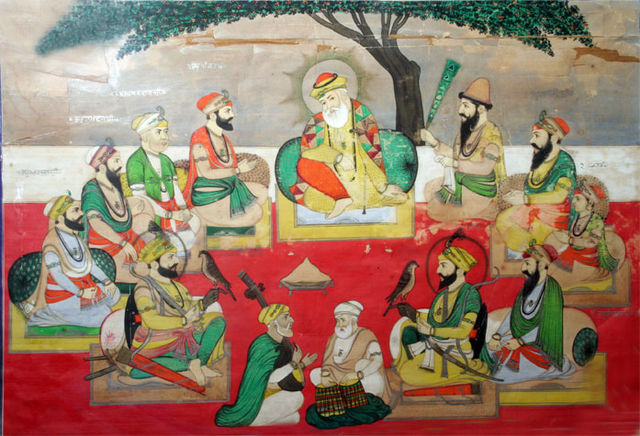Guru Gobind Singh was the tenth and last human Sikh Guru. He was a warrior, poet, and philosopher. In 1675, at the age of nine he was formally installed as the leader of the Sikhs after his father Guru Tegh Bahadur was executed by Emperor Aurangzeb. His father was the ninth Sikh Guru. His four biological sons died during his lifetime – two in battle and two executed by the Mughal governor Wazir Khan.
Contemporary painting of Guru Gobind Singh (seated) found within a Dasam Granth manuscript of Anandpur Sahib
Guru Gobind Singh's birthplace in Patna, Bihar
Guru Tegh Bahadar and a young Gobind Das at the Anandpur Darbar
Artistic depiction of "Dusht Daman", the alleged previous incarnation of Guru Gobind Singh as narrated in the "Bachittar Natak"
The Sikh gurus are the spiritual masters of Sikhism, who established the religion over the course of about two and a half centuries, beginning in 1469. The year 1469 marks the birth of Guru Nanak, the founder of Sikhism. He was succeeded by nine other human gurus until, in 1708, the Guruship was finally passed on by the tenth guru to the holy Sikh scripture, Guru Granth Sahib, which is now considered the living Guru by the followers of the Sikh faith.
A miniature painting, dated 1890, depicting an "imaginary portrait" of the ten gurus and others.
Gurus of the Sikhs. Fresco from Dera Nirmala, Tanda-Hoshiarpur.
Imaginary Meeting of Guru Nanak and the rest of the Sikh Gurus, Bhai Mardana, and others. 1780 painting
Image: Detail of Guru Nanak from the earliest known painting of all ten Sikh gurus together, with each being identified in golden Persian nasta'liq script, probably painted in Hyderabad, circa 1780








